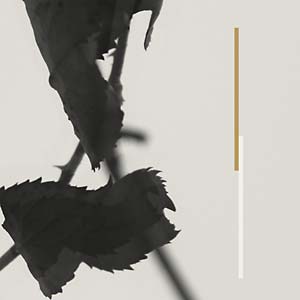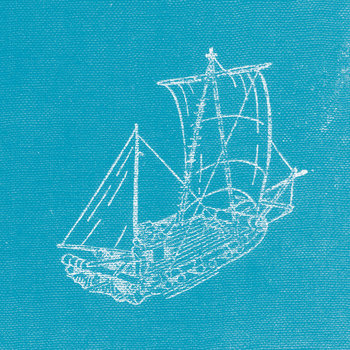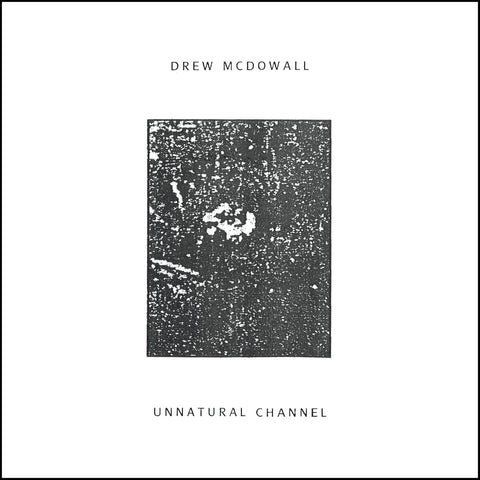News & Events

Bill Orcutt–his first solo electric studio LP—shocks with its space and sensitivity. On this eponymous record, Orcutt mines the expansiveness and sustain possible on the electric guitar, letting notes spin out and decay at the edge of feedback. His pachinko-parlor pacing, marked by unraveling clockspring accelerandos crashing into unexpectedly suspended tones, is still in evidence. But here, his developing melodicism maps a near-contemplative mental realm, orbiting St. Joan-era Loren Connors more than the cascading treble clatter of his duo LPs with Chris Corsano and others. From the first notes of Ornette Coleman’s "Lonely Woman," there's a lucidity and slow-burning lyricism that make Orcutt's plunges into barbed-wire fingerpicking all the more striking. While no one’s about to mistake Orcutt for Jim Hall, you could probably play this for your jazzbo friends (should you be unlucky enough to have them) without raising any eyebrows.
Orcutt's track selection mirrors his obsession with American popular song in its most banal manifestations, as radically reimagined via acoustic guitar on a variety of releases, including 2013's exhaustive Twenty Five Songs 7" box set, and the Mego LP A History of Every One. Many of the songs from those two releases are here–but stretched into new arrangements that explore the upper regions of the guitar neck (hitherto unexplorable on his shakily-intonated acoustic Kay), and lighting up new corners of each arrangement with a sensitivity born from years of reinterpretation. The result is a languid, freeform drift through Orcutt's internal cosmos into galaxies unknown to their original interpreters–and occasionally, Orcutt himself. Most striking is "White Christmas," its careening low-register melodies crashing into complex chords that transcend Orcutt's primitive four-string fretboard.
Orcutt's original compositions are equally striking. One of them—"The World Without Me"—is unique to this LP, and notable for its trebly flurry of Clapton-esque 12th-fret drizzle. "O Platitudes!" by contrast, spins ever-faster in the cadence of a hand-cranked music box, before grinding to a near halt, its higher-key electricity standing in for the moaning vocalizations on Orcutt's acoustic rendition as heard on his 2014 VDSQ LP.
With its deep-space beauty, harmonic complexity, and dark dissonance, Bill Orcutt is a stunning landmark in Orcutt’s form-destroying trajectory.
More information can be found here.

There is a station where the train never arrives, where the Waiting Room is always occupied, where the conversation is inevitably awkward and where you’re never quite alone, but perpetually ALMOST alone.
Ladies & Gentlemen, welcome to Station Yellow Moon, the final bastion of humanity, the last stuttering blip on the life support system, the domain where Access Is Denied perpetually – but who the Hell would want to go there anyhow? Well, some pay handsomely for the Great Escape, despite the risks….
High On Station Yellow Moon is a new solo album by Edward Ka-Spel of The Legendary Pink Dots, and marks the beginning of his collaboration with long-time friend and fellow traveler Amanda Palmer of the Dresden Dolls.
It doesn’t get more conceptual than this.
More information can be found here.

Major new work from Kara-Lis Coverdale, her solo debut vinyl release following Aftertouches (2015). A blissfully introspective 22 minute piece for keys, samplers and EQs in three parts.
A sublime and quietly hypnotic work belied by steadfast conceptual rigour, Grafts is the most ambitious and involving work yet from Kara-Lis Coverdale, her first since 2015.
In three parts of cascading yet plaintive multi-instrumental gestures, Grafts expands on the processing and self-temperment techniques explored on 2014's A 480 into a more encompassing palette. Uncompromisingly distinct while redolent of modal minimalism, '70s, new age, and folk music, Grafts effectively blurs distinctions between traditional composition and more open, overlapping genres that hover in the half-light between acoustic and electronic refinement.
Rather than anything grandiose or explicitly seductive, the effect of Grafts is best compared with the subtle intoxication of micro-dosing on LSD or the clarity afforded by quiet meditation, in a sense dilating the listener’s focus to a heightened awareness of the piece’s intricate peripheral tones as much as its melodic centerground, with a beautifully understated, surreal resolution. The piece flickers with gentle optimism, never at random, illuminating unseen spaces that quickly gradient into nothingness.
In both concept and execution, Grafts firmly resonates with Kara-Lis Coverdale's deeply established roots as an improvisational virtuoso and accomplished pianist as much as her academically informed approach to electroacoustic composition that showcases a distinct omnivorous appetite for the digital. But it's an emotional generosity that proves to be its defining, most intangible characteristic. Never fully coming to a resolution. Lingering on like a slowly dispersing plume of smoke.
More information can be found here.

Mike Cooper's output of the past half century has been described as "post-everything." It's a fitting phrase really when you consider he has been at the beating heart of so many critical musical moments. From the development of the blues touring circuit in the UK, through the growth of the folk scene and into the explosion of free improvisation that came to define a generation of UK musicians. Amidst it all, working at stitching these disparate forms into some kind of deterritorialised zone, was Mike Cooper.
It’s fitting then, that he explores the notion of journey on his latest full length edition. Even more fitting that he examines the vessels that carry us on journeys. With Raft, Cooper charts his interests in ambient exotica and collides it with his research into various South Pacific musical traditions. The record extends his palette considerably, stretching away from the hypnogogic flows of his master piece Rayon Hula, into a more oceanic setting. "Raft 21 Guayaquil To Tully," for example, sets out a lilting rise and fall of harmony which erupts with spluttering electronics.
Specifically inspired by Vital Alsar and William Wills, sailors who undertook some of the 20th centuries most impressive solo voyages, Raft reflects upon the determination of the solo traveller. In a musical sense, Mike Cooper's work of recent years has very much reflected a determined solo traveller work ethic. In his commitment to travel alone, he has developed a range of strategies that he works against as a means of surprising himself and uncovering unfamiliar sonic relations.
This approach has proved an incredibly fertile pursuit for Cooper, arguably producing some of his most affecting and engaging works, his Room40 albums Fratello Mare and White Shadows Of The South Seas amongst them. Raft is a vital record that sets its sights beyond the horizons of convention and in doing so reveals a perspective that is only available to lifelong voyagers such as Mike Cooper.
Out July 7, 2017 on Room40.

Kate Carr melds the exquisite details of her field recordings with an ephemeral approach to the song. This Australian has relocated herself to London after many trips around the globe. With each orbiting journey, she has collected innumerable sounds from the urbane to the aqueous and from the frenetic to the sublime, contextualizing all of these into compositions rippling with primordial melodies through guitar, piano, voice, and electronics. The Story Surrounds Us follows her highly acclaimed albums I Had Myself A Nuclear Spring (first released on her own Flaming Pines imprint in 2015) and Carr's debut for Helen Scarsdale in 2016, It Was A Time Of Laboured Metaphors. Emblematic of her work is a gentle dislocation between the environmental sounds and her drone-dub ellipses of somnambulant melody. The clatter of a frozen dock or a vibrational shimmer from rustled objects or the unintelligible whispers displaces the sense of self amidst a sea of disparate symbols and coded thought. More a travelogue in and out of one's own body than to any particular place. Carr suggests "In a way, it is about restlessness, an uncomfortable tossing and turning in all these many different places, a struggle somehow to forge a connection between my own internal world and all these places and persons I have encountered. I think this holds a sense of unease and strain, with both beautiful and failed moments of intimacy and connection which are made either possible or impossible in the difficult and distorted context of being away. It is quite sad, really." Look to Carla dal Forno, Alan Lamb and those moments of clarity in the shapeshifting ethos from Jewelled Antler for neighboring sounds to Kate Carr's chimerical compositions.
more information can be found here.

A few years ago we received an anonymous email with a link to three tracks and a simple message: "Hi, maybe you would be interested in this music." It’s easy to be skeptical of yet another link from yet another artist in a world overcrowded with them, but listening is our job and so we do it. The songs were instantly striking: extraordinarily slow, somber, and spacious, each vaulted cathedral chord reverberating poetically into the distance, the melodies rolling out like fog across a cemetery. Captivated, we requested more, receiving a single word in response: "Yes." Then, nothing. Eventually, three months later, we received another email with slightly more information: a name (Irma Orm), a location (Stockholm), and a bit of context (she worked alone, and progress on music was slow but steady).
Fast-forward to mid-2016: we're informed the album is complete, and it is breathtaking. Hermetic gothic swan songs conjured from funereal piano, twilit ambience, minimalist percussion, and spellbinding vocals. The mood is lulling and lush but lost in sorrow, stark grey structures looming in the night. Majestic open spaces between notes heighten the melancholic grandeur of Orm's arrangements, blurring the line between lament and lullaby. The songs less end than ebb away, succumbing to their own downcast beauty.
More information can be found here.

There is a playfully cryptic euphoria embedded in Luke Younger's work as Helm. An expansive constellation of references from across electronic music converge in his output, driving its narrative in and out of the heights of exploratory sound practices, covertly repurposing pop's prosthetic limbs on the side. His latest record, World In Action, broaches the ever-present—and ever agitated—political thread that has been pulled through the project's most opaque regions with a reinvigorated immediacy and purpose.
Recorded across East London, South-East Kent and Snaresbrook Crown Court at the height of the UK media's attempt at divining integrity from the orchestrated turbulence of Brexit, World In Action presents four pieces that juggle the documentation of this particular moment with the desire to discern motivation from despair.
Frenetic woodwind instrumentation is guided through cyclonic synth pads in slow motion, while Valentina Magaletti's percussion scatters the surface, scrambling the after-image of each piece as it propels us to the next. With a nod to industrial rock's breakbeat excursions, field recordings drenched in longer than long ago gather these elements into a worn path through unimaginable terrain.
The track titles recollect a time of just accountability and presence in the UK's mass media. This is a direct manoeuvre on Younger's part, setting World In Action up as a sceptical, yet hopeful work, unafraid of the deep political anguish that underpins its intent.
More information can be found here.

On the Echoing Green is an elegant work of lush, shimmering sound, rendered with a singular touch by eternal electric romantic Jefre Cantu-Ledesma.
In contrast to the haze and hermetic process of previous albums, Green was conceived as a deliberate experiment in clarity and collaboration: "I was interested in trying to bring out more overt pop elements, to let them come to the front and be present. I also have more trust now in letting things happen – trusting other people’s musicianship, and being open to people’s ideas. Eventually, things emerge."
What emerged from this bond are eight rapturous and richly melodic slow dives of swirling guitar, bass, synthesizer, piano, and drum machines, dramatically accented in places by heavenly arcs of voice courtesy of Argentinian singer-songwriter Sobrenadar. Cantu-Ledesma encouraged chemistry and intuition in the studio by beginning the album without any demos for reference; he and his collaborators pursued patterns and hypnotic textures across long-form improvisations until gradually songs began to take shape.
This is music of growth and grandeur, of ascent and exploration, played with purpose and passion by a craftsman in tune with the beauty of sound and the harmony of light. In his words: "[This album] feels like spring – things coming alive, blooming, emerging from winter."
More information can be found here. Out in June 2017.

After the long overdue release of Drew McDowall’s debut solo album Collapse in 2015, the experimental music underground saw McDowall as an arrival of an artist that was always here, hiding in plain sight. He was quietly in the background, pulling the levers on some of the most influential recordings in electronic music and with shifting his focus from the role as band member of such legendary acts as Coil & Psychic TV along with his recent collaborative efforts alongside Tres Warren (of Psychic Ills) in Compound Eye, McDowall came to finally identity as a singular artist and figurehead to a movement that has vitally required his presence.
His second full length endeavor for Dais Records is aptly titled Unnatural Channel, allowing McDowall to allocate offerings to the ghosts of his past using methods not fully understood. Moving forward from the impact left with his first album, Unnatural Channel moves McDowall into more uncharted territory. From the opening mark, Drew’s distinct fingerprint is evident on the track "Tell Me the Name," his signature ambient ebb and flow to pulsing electronics painted over reverberated percussions that have been pulled apart and spun around the spectrum.
Once the introduction has been made, the album moves forward into more rhythmic territory using classic industrial structures found on his previous work but fused with tumbling aural friction complimented by more techno-based cadence. Views into McDowall’s unconscious are ever-present in "This Is What It's Like," a reflective decent into madness brought on by the anxiety of sleep deprivation. Looping the title mantra, the listener gets caught into the author's own delusion and lost within the auditory hallucination.
The two part suite of "Unnatural Channel" subjects us to a torrent of fluttering and panic-stricken electronics, subtle in its dispatch but powerful in its impact. Field recordings of the most personal, hypnogogic dream-state, lost within itself until McDowall unveils his unbalanced, sequential patterns of fibrous, metallic waveforms and subsonic bass kicks that hit the air with such strength and coercive force that it is impossible not to be converted.
Ending with the statement of "Unshielded," the album ties off with the primal voice talents of artist Roxy Farman of the Brooklyn avant-techno duo Wetware. Roxy’s confused phrasing seemingly crashes head-on with McDowall’s cathartic finale, using every method of sonic hypnosis at his disposal to finish with a bold yet disconcerting assurance.
Out May 26, 2017 on Dais.

Last year, Mary Lattimore's At The Dam marked a watershed moment for the classically trained harpist. While over the past decade she had recorded and performed with notable talents like Kurt Vile, Sharon Van Etten, Steve Gunn, Jarvis Cocker, Meg Baird, and Thurston Moore, Mary’s acclaimed third solo full-length (her first long-player for Ghostly International) saw her own music deservedly embraced by a wider audience. It was certainly no small feat coming from a beguiling album of improvised, processed harp pieces that had been recorded during stops along a road trip across America – all funded by an esteemed fellowship that she received from the Pew Center for Arts & Heritage.
Out April 14 on cassette and digital, Collected Pieces is a gorgeous counterpart to At The Dam, featuring six tracks previously available only as a download and/or streaming off Mary's Bandcamp and SoundCloud pages. Recorded at her old home in Philadelphia between 2011 and 2016 and mixed by longtime collaborator Jeff Zeigler, Mary is reflective when describing this album-length compilation. “It’s me opening a box filled with 12 years worth of memories made while living there, with lots of beauty and sorrow, as well as total sunshine, blurriness, and some darkness all housed within.”
Throughout Collected Pieces, she conjures a mesmerizing range of colors and emotions from her 47-string Lyon & Healy harp along with subtle augmentations of effects and processed electronics. Dedicated to Mary’s favorite beach town, Ship Bottom, NJ, 10-and-a-half-minute opener "Wawa By The Ocean" gently unfolds like a daydream, with the song’s delicate refrain slowly dissolving into a light wash of delayed plucks and sun-kissed countermelodies. "We Just Found Out She Died," however, takes a more celestial turn as her airy vocal harmonies shimmer underneath the meditative flutter of her harp. (The chimeric atmosphere is befitting of the song’s inspiration: Twin Peaks actress Margaret Lanterman, a/k/a the Log Lady, who sadly passed away shortly after Mary had seen her speak at a library in Philadelphia.) From the sweet yearn of "The Warm Shoulder" to the flickering drift of "Your Glossy Camry," Mary’s music is all at once intimate and inviting as she effortlessly balances her exquisite sense of melodicism with an inventive ear for experimentation.
"It's only in looking back that you realize how impermanent stuff always was, even though 12 years felt really long,"Mary explains. "The songs here have always been really special to me, and more so after bringing together these scraps and odes to memories of a burning motel, people from high school who are old now, or that Wawa convenience store on the Jersey shoreline which will probably always be there but is now so far away."
More information can be found here.

